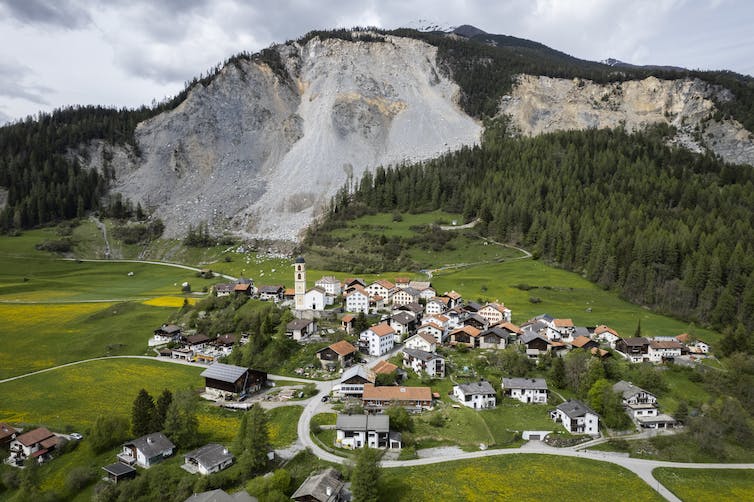In June 2023, in the eastern part of Switzerland, the small picturesque village of Brienz/Brinzauls narrowly avoided being wiped out by a huge landslide. The community sits at the foot of a steep slope that was on the move and eventually around 1.2 million cubic metres of rock collapsed, stopping just a few metres short of the village.
The landslide was predicted well in advance. The village had already been evacuated and there was intense media interest. The slope even had a YouTube live stream. As an expert in landslides who has been involved in these sorts of tough evacuation decisions before, I know those involved in the monitoring of the site, and making decisions around keeping the population safe, will have endured many sleepless nights.
Back in 2010 I was involved in the management of a landslide crisis in northern Pakistan. Here, 14,000 people were relocated from the path of a potential flood after a landslide blocked a river and created a new lake. The day to day pressures of decisions like these are enormous.
EPA-EFA / Gian Ehrenzeller
The situation in Brienz/Brinzauls was not new (the double name is because the village has a mix of speakers of German and Romansh, Switzerland’s fourth native language). Villagers first noticed the slopes around the village were moving a century ago, and more modern monitoring has indicated that the slope had been moving at a rate of seven metres per year or more. The deforming slope even extends beneath the village, which has already been damaged by the movement, although the crisis this year did not affect that part of the slope.
Gian Ehrenzeller / EPA
In 2022 the speed abruptly increased, and parts of the slope above the village started moving at over 25 cm per day, while individual rocks started detaching and falling down on the fields below. The steepness of the slope meant that a collapse seemed likely.
The challenge in these situations is in knowing when this might actually occur. And whether it will happen in a series of smaller landslides over weeks or even months, or as a single, more catastrophic event, that would be over quickly but would destroy the village.
Movement monitoring in detail
Over the past two decades, earth scientists have developed ways to monitor ground movement much more closely. This has allowed accurate assessment of the tectonic movement of continental plates, subsidence above coal mines, damage caused by tunnelling beneath cities, or the collapse of coastal cliffs.
Technologies include ultra-high-resolution GPS measurements, data from radar satellites and the use of robotic surveying instruments. The precision can be extraordinary – satellites located 800 km from the surface of the earth can detect movement of less than 3mm.
All these techniques mean the behaviour of slopes can be analysed in real time and scientists can quantify how they respond to external factors such as rainfall and earthquakes. It has even been discovered that some slopes respond to changes in air pressure as weather systems pass across the landscape. Usefully, these systems allow us to detect when a slope is moving dangerously fast, so that people can be warned and evacuated.
Jose Jacome / EPA
In the case of Brienz/Brinzauls, the slope had been accelerating through early 2023, although the exact causes were unclear. While short-term accelerations are common, sustained accelerations like this are a good indication that a collapse could be starting. In such circumstances, evacuation is prudent.
No one wants unnecessary evacuations
But relocating people, temporarily or permanently, is a huge issue. Understandably, many people struggle to cope, and there is ample evidence that relocated people often suffer from poor mental health and wellbeing.
Where the population is moved into a camp for displaced people, which often happens in less affluent countries (but fortunately not in Switzerland), the evacuees are prone to abuse, trafficking and destitution. Experience tells us that women and children are particularly vulnerable in such circumstances.
So there are good reasons to avoid evacuating people unnecessarily, or too early, while also ensuring that the potentially affected population is kept safe. Thus, evacuating at the right time is critical.
Gian Ehrenzeller / EPA
Unfortunately, it is very hard to predict exactly how and when a big rock slope will collapse. Big rock slopes that are accelerating towards a full landslide typically move in patterns that can be modelled mathematically, allowing predictions that can be remarkably accurate in some circumstances. But complexities in the ground conditions mean that many slopes deviate from this, often slowing down unexpectedly. In some cases, movement returns to a crawl, or even stops altogether for a while.
We do not have enough information about the ground at any site to be able to know what a change in movement rate means for future behaviour (in the case of Brienz/Brinzauls, the “active slope” was about three million tonnes of rock that was, of course, extremely difficult to access safely). The ground is simply too complex to allow simple characterisation. Such a slope could resume movement in a few hours, a few days or even a few years.
Scientists and civil defence officers monitoring such situations have to assess the conditions continuously, making judgements as to the future behaviour. A few years ago in Norway, Mount Mannen underwent repeated episodes of increased movement. The community at the foot of the slope was evacuated 18 times before the slope finally collapsed. The scientists were under immense pressure both to keep people safe and to avoid unnecessary disruption, all in the full glare of the national news.
The slope above Brienz/Brinzauls seems to have settled down since the big landslide in June. Yet as climate change continues to cause environmental change in high mountain areas, the situation there is likely to play out in many more locations. As a consequence, the challenges faced by the authorities in Switzerland are likely to become more common.

